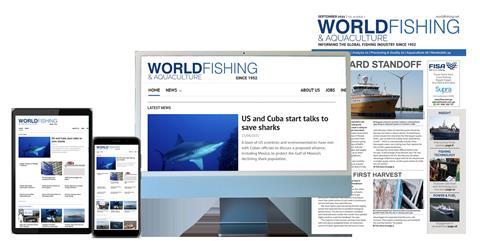- News
- Subscribe

Get full access to World Fishing & Aquaculture content
Including the digital magazine, full news archive, special reports, webinars and articles on innovations and current trends in the commercial fishing and aquaculture industries.
- Expert analysis and comment
- Unlimited access to in-depth articles and premium content
- Full access to all our online archive
Alternatively REGISTER for website access and sign up for email alerts
- Industry Database
- Events
Icelandic Fisheries Exhibition
Fish Waste For Profit Conference


The largest commercial fishing exhibition in the North Maximise return on investment from potentially discarded parts of the catch Visit the IceFish Website Visit the Fish Waste for Profit Website
- Special Reports
By-Product Solutions
Smart, Connected Seafood Processing
Land-Based Aquaculture Technology
Greener Fishing
January-February 2025 March-April 2025 July-August 2025 November-December 2025 



Cutting waste and maximising value Robotics, analytics software and other Industry 4.0 technologies are helping to scale-up productivity New production systems are escalating the industry’s contribution to global food security Fisheries are becoming increasingly responsible and sustainable thanks to new technologies and initiatives Read More Read More Read More Read More
Russia’s seafood industry tightens its belt

Profitability at its lowest level in a decade thanks to a rising fiscal burden, Western sanctions, expensive loans and an unprecedented labour crisis
In the first-half of 2024, the combined profit of fishing, fish processing and aquaculture companies in Russia decreased by 14.2% to RUB 60.2 billion (approximate US$550 million), according to a new study from the Russian Association of the Fishing Fleet Shipowners.
While the entire Russian economy is generally not faring well this year, with estimates made by the Russian state statistical service Rosstat finding the net profit of firms decreased by an average 1.8% in the first six months, the seafood industry ranks among the worst financial performers. Indeed, fishing industry union VARPE has calculated that nearly every second Russian fishing company was loss-making in the period.
This downturn is nothing new. It’s reckoned its financial health has been steadily deteriorating at least since 2022, and last year’s net profit fell by 15% to RUB 102.2 billion ($1.1 billion).
A key factor impacting profitability is a hike in the Central Bank’s key interest rate, says the Russian Association of Fishing Fleet Shipowners. The organisation noted that in a bid to tame inflation, the Russian Central Bank jacked up the key interest rate in several rounds to 19% as of early October 2024. In 2021, it was as low as 4.25%.
The high interest rate makes commercial loans for much more expensive, the association explained. For the Russian fishing sector, the cost of loans is particularly important since the largest players have no choice but to invest in new fleets and processing infrastructure to honour their obligations taken under the government-run investment quotas programme.
When this programme kicked off in 2017, Russian fishing companies pledged to build new vessels at domestic shipyards and fish-processing infrastructure in key fishing regions in exchange for fishing quotas.
Now though, there’s evidence the government has been stepping in in to alleviate the financial predicament, and Irina Zhvachkina, Deputy Director of Rosselhozbank, the leading agricultural bank in Russia, confirmed that of the RUB 24 billion ($280 million) of commercial loans taken by the Russian fish industry in the first-half of 2024, nearly half were loans with state-subsidised interest rates. The other half, however, were taken with interest rates of around 22% to 25%, which is far above the industry’s profitability.
Nevertheless, the industry’s investment potential is estimated at RUB 600 billion ($6.5 billion) through 2030, Zhvachkina said.
Continue this article…
Already subscribed? SIGN IN now

Register for a FREE one-month trial to continue this article
Want to read more before deciding on a subscription? It only takes a minute to sign up for a free account and you’ll get to enjoy:
- Weekly newsletters providing valuable news and information on the commercial fishing and aquaculture sector
- Full access to our news archive
- Live and archived webinars, podcasts and videos
- Articles on innovations and current trends in the commercial fishing industry
- Our extensive archive of data, research and intelligence
Get more free content sign up today
Ready to subscribe? Choose from one of our subscription packages for unlimited access!


